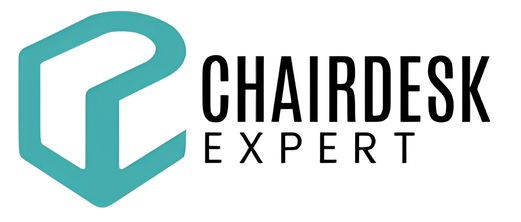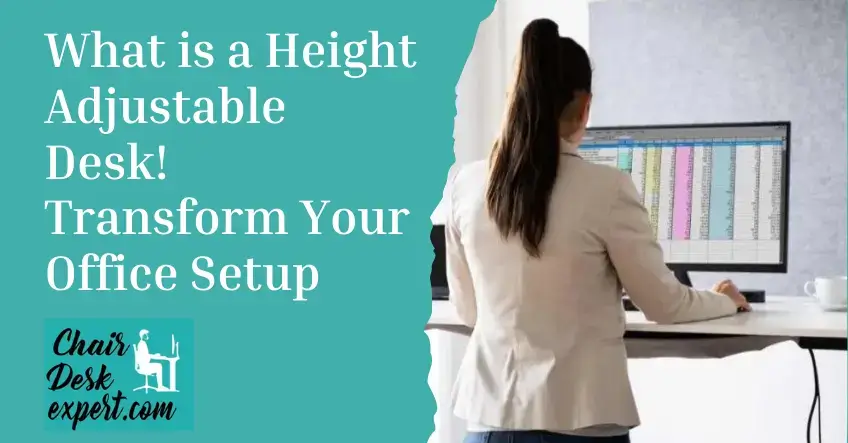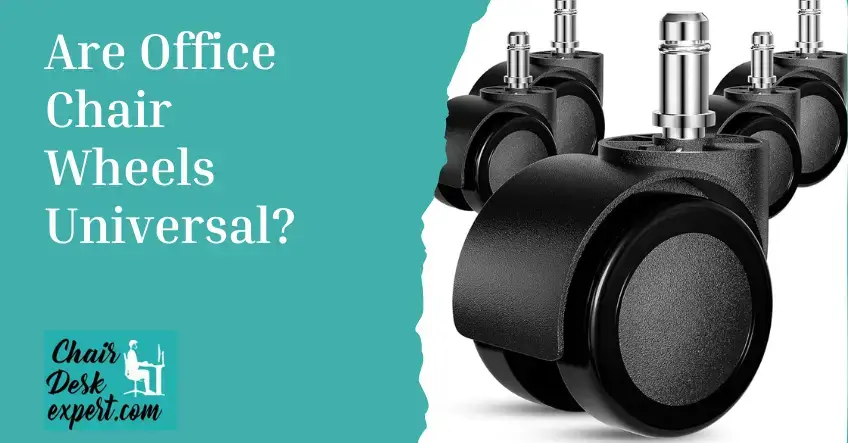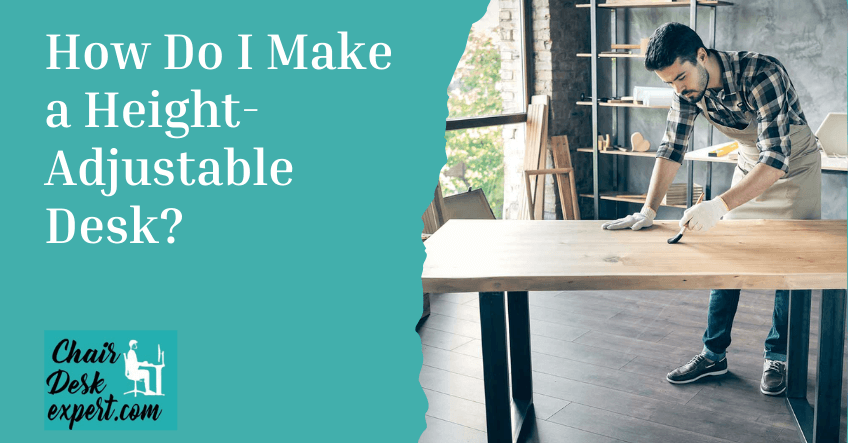What is a height adjustable desk? Do you know about it? In recent years, the popularity of height-adjustable desks, also known as sit-stand desks, has surged as people become more aware of the health risks associated with prolonged sitting.
Chair desk expert provides all the details related to the ergonomic chairs and desks including there types, pro and cons of different furniture and cost details etc. This article is about the height adjustable desk.
These desks allow users to easily switch between sitting and standing positions, aiming to create healthier and more comfortable workspaces. Despite their promising benefits, it’s essential to consider both the advantages and disadvantages before deciding if a height-adjustable desk is the right choice for you.
This article provides a comprehensive guide on what is a height-adjustable desk, to help you make an informed decision.
What is a height adjustable desk? (Detailed Pros and Cons)
Below is the detailed analysis on what is a height adjustable desk and its pros and cons.
These desks aim to create healthier, more comfortable, and productive workspaces. The rise of height adjustable desks is a response to the negative health impacts of prolonged sitting. Research suggests that sitting for extended periods can lead to issues such as aching shoulders, back problems, and chronic joint pain.
Moreover, a sedentary lifestyle has been linked to an increased risk of heart disease, obesity, diabetes, and cancer. A study found that nearly half of individuals using height-adjustable desks reported decreased upper back, shoulders, or neck discomfort.
In Scandinavia, these desks are prevalent, with a high percentage of computer users in countries like Norway, Sweden, Finland, and Denmark utilizing sit-stand desks. In Denmark, it is even a legal requirement for companies to offer employees the option of using such desks.
Pros of Height Adjustable Desk

Height-adjustable desks address the health concerns associated with prolonged sitting. Research indicates that sitting for more than 8 hours a day increases the risk of early death, cardiovascular disease, and type 2 diabetes.
1- Encourages Movement: These desks promote regular intervals of stretching and movement as employees can easily switch between sitting and standing while working.
2- Improved Productivity:
Studies show that productivity tends to increase when individuals stand at their desks. The motivation to complete tasks is higher, leading to enhanced work efficiency.
3- Increased Mental Activity:
Human brain activity is reported to increase by up to 20% when working at a height-adjustable desk. This results in faster and higher-quality decision-making processes.
4- Time Savings:
The efficiency gained by using sit-stand desks can save time in the long run. Productivity increases by at least 10%, allowing for more efficient task completion and additional time for other projects. Reduced absenteeism due to conditions caused by prolonged sitting is also noted.
5-Cost Savings:
Employees working without constant fatigue, neck tension, or back pain tend to be more efficient. Studies suggest that companies experience significant annual losses due to absenteeism and reduced productivity caused by back problems. Height-adjustable desks contribute to reducing these costs in the long term.
6-Improved Meetings:
Standing meetings are associated with better communication. Studies by behavioral experts indicate that people communicate more effectively while standing, with a fuller, more dynamic, and convincing voice, ultimately enhancing overall meeting performance.
These pros highlight the positive impact of height-adjustable desks on employee health, productivity, time management, and overall workplace dynamics.
Cons of Height Adjustable Desk
Lack of Guidance: Workers may not fully benefit from height-adjustable desks if they are not provided with proper guidance on how to use them. Without instructions on setup, appropriate height adjustments, and usage, the potential advantages may be lost.
1- Not Suitable for Creative Work:
Some argue that certain types of creative work, such as writing or designing, are more challenging while standing. This limitation may render height-adjustable desks less suitable for individuals engaged in creative tasks.
2- Discomfort and Breaks:
Workers standing for extended periods may experience discomfort, leading to more frequent breaks. Although height-adjustable desks provide the option to sit, some individuals may find standing for long durations less comfortable.
3- Health Risks of Prolonged Standing:
Prolonged standing can contribute to issues like poor posture, sore feet, and tightened joints. To maximize benefits, it is advisable to alternate between standing and sitting rather than adopting one position for too long.
4- Higher Cost:
Height-adjustable desks are generally more expensive than standard desks. While the initial investment may be higher, proponents argue that the long-term benefits and improved employee well-being justify the cost.
5- Risk of Ineffective Implementation:
Without a well-planned implementation strategy, the introduction of height-adjustable desks may not achieve the desired outcomes. Proper training and communication are essential to ensure employees use the desks effectively.
Considering both the pros and cons allows businesses to make informed decisions about the adoption of height-adjustable desks in the workplace. There are many drawbacks of using non-ergonomic chairs and desks.
Why buy a Height Adjustable desk?
Height-adjustable desks offer a range of benefits that make them a valuable investment for modern workplaces. Above we give you detailed on what is a height adjustable desk Here’s why you might consider incorporating them into your office:
1- Health Benefits:
Height-adjustable desks contribute to employee well-being by allowing them to switch between sitting and standing positions. This dynamic movement helps reduce the risks associated with prolonged sitting, such as back pain and stiffness.
2- Improved Productivity:
Research indicates that employees working at height-adjustable desks experience increased motivation and productivity. The flexibility to choose between sitting and standing can create a more comfortable and engaging work environment.
3- Employee Empowerment:
Providing workers with the option to control the height of their desks gives them a sense of autonomy over their workspace. This empowerment can contribute to job satisfaction and a positive work culture.
4- Customizable Workstations:
Height-adjustable desks cater to diverse needs, accommodating employees of varying heights and preferences. This customization ensures that each individual can set up their workspace according to personal comfort and ergonomic requirements.
5- Future Workplace Trends:
As workplaces evolve, height-adjustable desks align with the trend toward smart and adaptable offices. The potential integration of technology, such as apps controlling desk height, temperature, and lighting, reflects the innovative direction of modern work environments.
6- Employee Feedback:
Before deciding, seeking input from employees about their current workstations and preferences is crucial. Understanding their needs and desires regarding workspace flexibility can guide the decision-making process.
Investing in ergonomic furniture like drafting chairs, standing desks and height-adjustable desks involves not only providing ergonomic solutions but also fostering a workplace that prioritizes employee health, satisfaction, and adaptability to future trends.
FAQs: What is a height adjustable desk?
Q-1 What are the different types of height adjustable table?
Height-adjustable tables come in various types, including manual, electric, pneumatic, and counterbalance models. Manual tables require physical effort to adjust, while electric ones use motors for convenient height changes.
Q-2 What material is a height adjustable desk?
Height-adjustable desks are commonly manufactured using a variety of materials, including light-weight aluminum and durable steel. These materials contribute to the desk’s durability and dependability, allowing users to seamlessly adjust the desk’s height to their preferences.
Q-3 What are the best desk heights?
The best desk height depends on individual factors such as height and seating preferences. For most people using a conventional task chair, a standard desk height of 28″ to 30″ works well, especially if they are between 5’8″ and 5’10” tall.
However, for individuals who are taller or shorter, adjusting the work surface height may be necessary.
What is a height adjustable desk? Wrapping Up
We hope you get enough knowledge on, what is a a height-adjustable desk and its pros and cons.
It is a versatile workspace solution that allows individuals to easily switch between sitting and standing positions. This flexibility offers numerous health benefits, improved productivity, and a sense of control over one’s working environment.
As workplaces evolve, height-adjustable desks become integral to creating ergonomic and adaptive workspaces. Considered a key element in the future of the workplace, these desks cater to individual needs, promoting overall well-being and enhancing the work experience.









